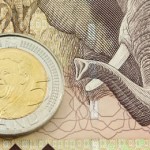Gold continued its downward trend for a sixth consecutive day, reaching the lowest in more than four years with no indication of stopping, as the US dollar strengthened further and assets in the SPDR Gold Trust slid.
Comex gold for delivery in December traded at $1 147.5 per troy ounce at 9:18 GMT, down 1.73% on the day, having earlier dropped to $1 142.4, its lowest since April 2010. The precious metal fell 0.18% on Monday and closed at $1 167.7.
A key technical support level of around $1 180 was broken on Friday, turning into a resistance level, and kept pushing the price down. The downfall came after Bank of Japan expanded its stimulus program, further increasing the strength of the dollar. Analysts at ScotiaMacatta predicted that once the $1 180 level was breached, prices could go down to $1 155 and more and “only a close back above $1 200 would shift our view from bearish to neutral.”
The low cost of the metal caused a slight increase in coin demand in Europe and the United States, however sales in China, the worlds top gold consumer, proved disappointing. On Wednesday, local prices on the Shanghai Gold Exchange offered a discount of $0.50 an ounce compared to the global benchmark, which points towards weak demand. Gold is heading for its first consecutive yearly loss since 1998 following twelve straight years of increases.
After Fed officials wrapped up their 7th annual meeting and announced the end of its monthly bond purchase program, they said that if their targets of full employment and stable prices are met faster than expected, they would increase interest rates sooner. However borrowing costs remain low for now and will stay that way for a “considerable time”.
The US dollar rallied further, supported by expectations for another round of solid US economic data and as the euro fell.
The US dollar index, which measures the greenback’s performance against a basket of six major trading peers, surged to the highest in more than four years. The December contract rose by 0.54% to 87.560 by 9:18 GMT, having earlier risen to 87.610, the highest since June 2010. The contract fell by 0.36% to 87.092 on Monday.
Automatic Data Processing is expected to report on Wednesday that US employers in the non-farm private sector added 220 000 jobs in October, compared to 213 000 in September. If confirmed, this would be the highest payroll gain since June.
Later in the day, Markit Economics is expected to report a slowing growth in the US services sector in October, with the respective Services PMI projected to confirm a preliminary reading of 57.3, compared to 58.9 a month earlier. The report is due at 14:45 GMT.
The Institute for Supply Management is also anticipated to report a slowdown in the sector, with its ISM Non-Manufacturing PMI likely to register at 58.0, down from 58.6 the previous month. ISM’s figures will be released 15 minutes later.
Assets in the SPDR Gold Trust, the biggest bullion-backed ETP and a proxy for investor sentiment towards gold, decreased 2.39 tons on Tuesday to 738.82 tons, reaching the lowest since September 2008.
Pivot Points
According to Binary Tribune’s daily analysis, December gold’s central pivot point on the Comex stands $1 168.7. If the contract breaks its first resistance level at $1 174.0, next barrier will be at $1 180.3. In case the second key resistance is broken, the precious metal may attempt to advance to $1 185.6.
If the contract manages to breach the S1 level at $1 162.4, it will next see support at $1 157.1. With this second key support broken, movement to the downside may extend to $1 150.8.





